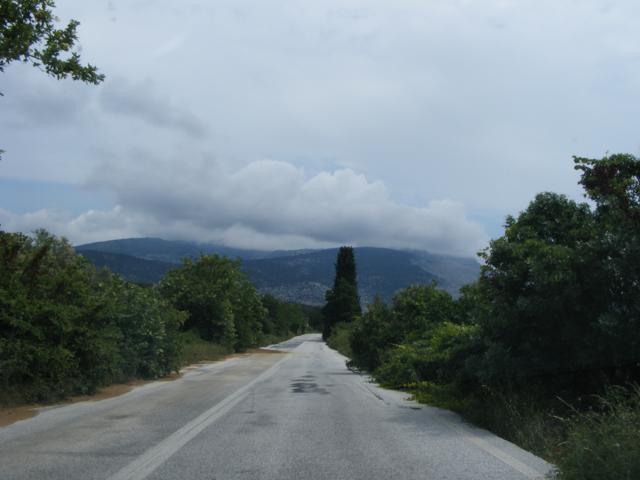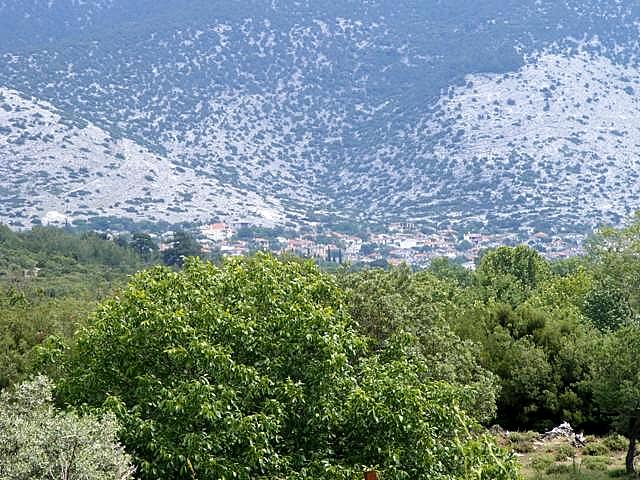Zona a fost locuita inca din era bizantina, iar in timpul ocupatiei turcesti (1455-1813), jumatate din sat era grecesc, jumatate turcesc. Podul de piatra – construit in sec. al XVIII-lea – care unea cele doua parti se poate vedea si azi si este unic in felul sau pe insula. El se afla in apropierea intrarii in sat.
Am fost aici si in 2010, cand am mers direct in centru si nu am stat prea mult. Acum am apucat pe un drum care inconjoara satul pe deasupra sa, ca sa il putem admira de sus. La inceput, credeam ca ne va alunga ploaia, apoi a iesit soarele si ne-a facut ziua frumoasa. Aici sunt mai multe case vechi, acoperite cu placi de piatra. Materialul se ia chiar de pe dealurile din stanga noastra.
De altfel, aici, la marginea dealului e si o vegetatie tare fotogenica…
La plimbare prin sat am trecut pe langa o Manastire a Sf. Arhanghel Mihail si un Muzeu etnografic (inchis), un atelier de pielarie, unde se fac chiar sub ochii clientului, pantofi si sandale de tot felul. O pereche de sandale de piele se invarte in jur de 35 euro. Eram deja obisnuiti cu atmosfera acestor sate de munte. Dintre toate, Theologos este parca cel mai turistic. O multime de pravalioare vand miere si dulciuri facute cu miere, ulei de masline si tot felul de cosmetice pe baza de ulei de masline, lokum cu diverse arome. Aceste produse sunt exponentele ocupatiilor localnicilor.
Ne-am abatut putin si pe la Biserica Sf. Dimitrios (construita in 1803), evident inchisa. Incercasem si in 2010 sa o vizitam dar tot fara succes.
In sat sunt si cafenele si taverne unde, in timp ce va odihniti, puteti gusta din bunatatile locale, preparate toate cu ingrediente proaspete, cultivate in sat.
Dupa ce mai vedem si batrana moara de ulei, ne oprim si noi la o taverna, pentru o binemeritata odihna si o bucurare a simturilor…






I envy your travels.
Randy: 🙂
Wow, what a fascinating place! I love how ancient the land feels here, the abundance of stone, the old houses. I especially enjoy the details you find. That’s a fantastic old bridge too. Wonderful post TH!
I love this stone bridge! It’s wonderful. And the village is also superb:)
Great photo’s and nice places…..thanks for this post.
Greetings, Joop
Hello, Traveling Hawk.
Your heartwarming works fascinates my heart.
Thank you for your kindness and support.
And i pray for you and yours peace.
Have a good week-end. From Japan, ruma❃
This is the first time i have come across stone tiles used like terracotta tiles( I mean they were laid like them) on the roofs of the pretty cottages/ houses. I too envy your travels, but in a positive way.
Thanks, Doug. The village is really wonderful.
Thanks, Joo! The bridge was hard to find but it was worth.
Thanks, Joop! Have a nice day!
Thank you, ruma, for your visit.
Thassos island is special, rama, and Theologos is a beautiful village. Thanks!
A blog with lots of pictures and also nice pictures. I never knew that the village was inhabited by Greeks and Turks, and that the two halves were later joined by a stone bridge. I again learned a lot in this blog Traveling Hawk 🙂
Thank you, Helma, for your enthusiasm!
Very impressive photos particularly once again the pavement cafe material … outstanding.
Thanks, J_on_tour! Theologos deserves a nice comment:)